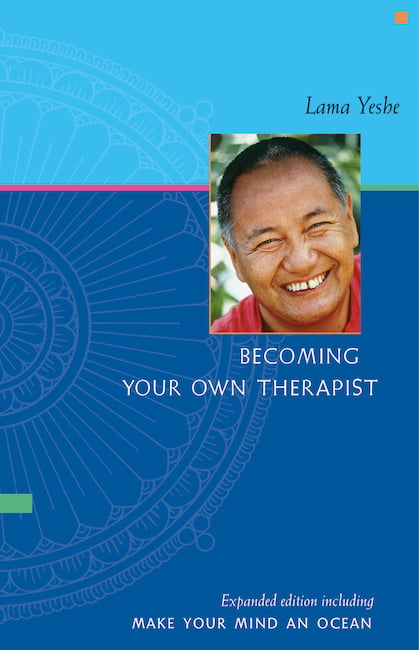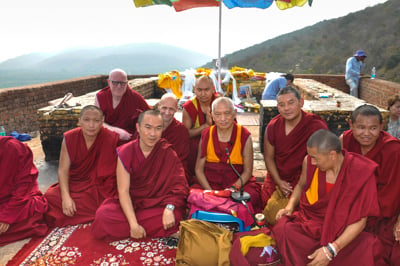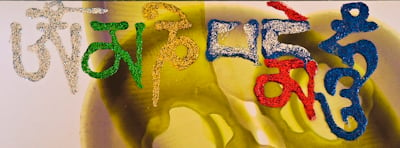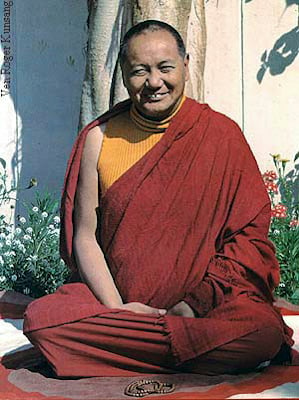Dear LYWA friends and supporters,
Thank you so much for your continued support of the Archive's mission. Together we are working to preserve the precious teachings of our Lamas and make them available to all in a myriad of ways.
Latest Book News We are hard at work preparing to reprint six of our most popular free book titles, including the ever-popular Becoming Your Own Therapist and Make Your Mind and Ocean combined edition. With these reprints the total number of LYWA books in print is over 675,000! This number is even more amazing considering that we are distributing more than 1,000 books per month as ebooks, and countless more readers download our books for free from our website, or read them online. We can all rejoice in how our work together has delivered these timeless words of Lama Yeshe and Lama Zopa Rinpoche into so many minds and hearts.
We are hard at work preparing to reprint six of our most popular free book titles, including the ever-popular Becoming Your Own Therapist and Make Your Mind and Ocean combined edition. With these reprints the total number of LYWA books in print is over 675,000! This number is even more amazing considering that we are distributing more than 1,000 books per month as ebooks, and countless more readers download our books for free from our website, or read them online. We can all rejoice in how our work together has delivered these timeless words of Lama Yeshe and Lama Zopa Rinpoche into so many minds and hearts.
We also rejoice that so many of our free books have been made available to prisoners around the country. Each month LYWA and Liberation Prison Project receive more requests for books from prisoners than we could possibly fill, so Ani Desal, our Office Manager at LYWA, came up with the idea to contact prison chaplains to establish a library of LYWA publications so that all the inmates of the prison would have access to our books. Ani D's idea has been very well received as so far she has succeeded in sending a copy of all of our books to 45 prisons in 20 states! One inmate who facilitates a Dharma study group in his prison wrote:
I wish to express our warmest thanks and gratitude for your recent donation of Dharma books. I want to assure you that your donation is deeply appreciated and will be well used.... On a personal note, you have my profound gratitude for sharing your compassion and generosity toward prisoners.... We have the profound opportunity of seeing and experiencing the results of our actions in a very direct way and the means to change the course of our lives if we are willing to apply the teachings. Your precious gift is helping to affect this transformation and set us firmly upon the Dharma Path.
We are always looking for opportunities to expand the reach of these teachings in all ways, and thanks to the incredible work of LYWA volunteer Alan Wilson we are able to offer more of our titles in Braille. See our page For the Visually Impaired for links to Braille versions of Lama Zopa Rinpoche's Virtue and Reality and Lama Yeshe's Becoming Your Own Therapist and Make Your Mind an Ocean and The Essence of Tibetan Buddhism. If you have any ideas for how to make these Braille versions more readily available to our visually impaired friends, please let us know.
As always, your donations to support any of our projects are always much appreciated.
New Lama Zopa Rinpoche Teachings Posted We have just posted the audio and transcript of teachings Rinpoche gave last month atop Vulture's Peak in Rajgir India. Thanks for Ven Sarah Thresher for preparing a lightly edited transcript and sending it along so quickly, and also for sending pictures and links to the audio! Rinpoche began by reading out a dedication prayer by Mipham Dawa Rinpoche, then, after the sutra transmission, Rinpoche led students in a meditation on emptiness.
We have just posted the audio and transcript of teachings Rinpoche gave last month atop Vulture's Peak in Rajgir India. Thanks for Ven Sarah Thresher for preparing a lightly edited transcript and sending it along so quickly, and also for sending pictures and links to the audio! Rinpoche began by reading out a dedication prayer by Mipham Dawa Rinpoche, then, after the sutra transmission, Rinpoche led students in a meditation on emptiness.
Ven. Sarah Thresher reports that, “Rinpoche’s voice was stable and clear and resounded as he guided us step by step on how to realize emptiness and cut the root of samsara.”
Read also an excerpt from a teaching given to students at Shantideva Meditation Group, New York, in September 2007, edited by Nancy Patton and published in Mandala magazine, February 2008. In this teaching Rinpoche gives advice on the essence of Dharma practice and the benefits of the Dharma center.
New Advice from Lama Zopa Rinpoche
Rinpoche gave practice advice to a student in which he is reminding her how Dharma practice is most important, and the power of reciting the Chenrezig mantra:
Even reciting OM MANI PADME HUM one time, the merit is unfathomable, even if every single drop of the Pacific Ocean is counted. The merits of reciting this mantra even just one time cannot be counted. Even if every single dust particle of the earth is counted, the merits of reciting this mantra cannot be counted; even if every single snow flake is counted, the merits of [reciting] this mantra cannot be counted; even if every single drop of rain is counted, the merits of this mantra cannot be counted. It purifies negative karma and the obscurations collected from beginningless rebirths, and it collects extensive merits and causes us to actualize the path to enlightenment. It particular helps us to develop compassion towards all living beings and to free the numberless sentient beings from the oceans of samsaric suffering and its causes by ourselves, and bring them to full enlightenment.
Read also advice Rinpoche gave to a student who wrote about her connection to Kuan Yin [Tib: Chenrezig] and her ability to heal with her hands, where Rinpoche encourages her to use this power to heal many people. And, you can read letters of thanks from students to Rinpoche, which Rinpoche requested be made available so others can rejoice. As always you can find the list of all Rinpoche's advices added in April here.

Drawing of OM MANI PADME HUM by Rinpoche
Amazon Smile
Some of you may be familiar with Amazon's program to support non-profit organizations, Amazon Smile. This program provides a way to have a portion of your Amazon purchase be offered back to the non-profit organization of your choice. If you are interested in taking advantage of this program, you would go to AmazonSmile to shop. The first time you go there, it will ask you to choose an organization. Just type in Lama Yeshe Wisdom Archive and it will find us. Now, when you shop through smile.amazon.com the Archive receives 0.5% of the sale as a donation. This is an easy way to transform a worldly activity into a Dharma activity!
We leave you with a teaching from Lama Yeshe given during the 12th Kopan Course in Nepal in 1979. You can read the entirety of this teaching by Lama including the question-and-answer session that followed—as well as the extensive teachings given by Lama Zopa Rinpoche during the entire course—on our website.
Thank you so much for your support. You make it possible for the Archive to continue in its mission to bring benefit to all.
Much love, 
Nick Ribush
Director
This Month's Teaching: Is Attachment Completely Negative?
 There are teachings in the lamrim that say we should be grateful for the eight worldly dharmas. Why is that? First of all, how can we gain liberation from samsara without transcending the eight worldly dharmas? Even Shakyamuni Buddha himself went through them on his way to enlightenment. It’s part of our spiritual evolution. At some point, having gone through the eight worldly dharmas, we reach beyond them, attaining liberation or even enlightenment.
There are teachings in the lamrim that say we should be grateful for the eight worldly dharmas. Why is that? First of all, how can we gain liberation from samsara without transcending the eight worldly dharmas? Even Shakyamuni Buddha himself went through them on his way to enlightenment. It’s part of our spiritual evolution. At some point, having gone through the eight worldly dharmas, we reach beyond them, attaining liberation or even enlightenment.
In his lamrim teachings, Lama Tsongkhapa very clearly describes three types of eight worldly dharmas: black, mixed and white**. When we engage in worldly activity, one aspect of our action might be good, but as we’re doing it a negative thought can arise so that the result will be sort of mixed. So philosophically, and this is also in the lamrim, you can’t say that all attachment is negative. Westerners can be over-sensitive. They see in the lamrim that attachment is our biggest problem and conclude that it must be completely negative. Lama Tsongkhapa says, “No!”
Logically we can see that, from the Buddhist point of view, all human life, including our body, comes from the positive mind. It’s positive karma that produces this body that gives us the ability to enjoy things. But, as human beings, we have limitations. When the lamrim teachings highlight certain aspects of our life as negative, we can jump to the conclusion that everything to do with attachment is negative: “I am completely negative; the world is completely negative.” Then everything gets very dark, because that’s the exaggerated way in which we project or interpret it.
I want you to understand clean clear that we distinguish two things: negative, or sinful, and positive. Attachment, or desire, can be negative and sinful, but it can also be positive. The positive aspect is that which produces pleasure: samsaric pleasure, human pleasure—the ability to enjoy the world, to see it as beautiful, to have whatever you find attractive.
So you cannot say that all desire is negative and produces only pain. Wrong. You should not think like that. Desire can produce pleasure—but only temporary pleasure. That’s the distinction. It’s temporary pleasure. And we don’t say that temporal pleasure is always bad, that you should reject it. If you reject temporal pleasure, then what’s left? You haven’t attained eternal happiness yet, so all that’s left is misery.
But you should not make the mistake of trying to actualize temporary pleasure [as an end in itself]. You can enjoy it while you have it but you should not squeeze yourself striving for it. The problem is the mind that believes temporary pleasure to be the best there is. That’s a total delusion, an over-estimated conception. Like looking at a cloud in the sky and thinking, “What a beautiful cloud; I wish it would last forever.” You’re dreaming.
We should recognize all our human pleasures as similarly impermanent. They come; they go. They’re limited and we should expect them to be limited. That’s their nature. Our expectations should always be in accord with the way things are. Therefore we should not grasp at temporary pleasure as if it were eternal, everlasting happiness. That’s deluded, a fantasy.
Of course, the lamrim and Mahayana Buddhism in general talk about attachment and self-cherishing as incredibly big problems. And when you hear that, you might think, “I want to give them up today!” You can’t. It’s impossible; you’re too ambitious. You need to understand that attachment is a problem in everyday life because you have too many fixed ideas and unreasonable expectations. You can’t give all that up overnight. Work it out slowly: “I’m grateful to understand how attachment works, but it will take time to overcome it. There are certain things I can handle now but I can’t manage everything at once.”
Remember what I said about the mixed eight worldly dharmas—actions that are a little bit white and a little bit black so that the results are mixed too; not totally negative. So you have to see where you fall in this and use your own judgment when deciding how to deal with your own attachment. Just don’t look at all attachment as completely negative. It’s not. There are degrees of attachment.
You’ve probably heard about the five paths and the ten bodhisattva levels (bhumi). For example, there are the paths of merit, preparation and right seeing, at which point one attains the first bhumi. It’s quite a long journey. From there up to the eighth bhumi, you can still have some attachment. As I said, it has degrees.
Knowing this, we beginners should be encouraged that it is only when we reach the incredibly high eighth bodhisattva bhumi that we are completely free of attachment. Starting from where we are, we first deal with its gross levels and slowly, slowly rid ourselves of it.
So don’t be too idealistic: “How fantastic. Lama has told me all about attachment,” and then go home and tell your father, “Your problem is attachment,” your boyfriend, “Your problem is attachment.” Everything is attachment. Then people start telling you, “You know what? Your problem is attachment.”
Well, philosophically, we might understand attachment clean clear, but in practice we have to be reasonable and, as the lamrim explains, have a realistic attitude towards attachment. So, if you see some benefit for yourself or others in doing something, even small, although it might be tinged by attachment, do it. Do what you can; that’s good enough.
When some Westerners first encounter the lamrim teachings they get the impression that it’s all about suffering: “Buddhism says I’ve been suffering since forever! I should be suffering!” Since they’ve been brought up to believe that in fact they should not suffer and should always enjoy pleasure, they really don’t like this Eastern way of thinking and can’t reconcile the two. Have you felt like that? Anyway, it’s not true. Buddhism wants you and all other sentient beings to discover everlasting happiness and bliss; eternal peace. That’s the enlightenment experience; that’s the goal of the lamrim teachings. Don’t think that small worldly pleasures are the only happiness there is; that if you just have this thing or that, you’ll be happy. That’s small, narrow-minded thinking. And that’s the problem.
Worldly happiness is OK, but judge it reasonably. Enjoy it without grasping at it as real, which only results in more pain. That’s all that Buddhism is talking about. You should have pleasure and not feel guilty when you do. What do I mean by pleasure? It’s a feeling that satisfies you for a moment and doesn’t disturb your mind. You get a little pleasure—that’s good enough. Accept it for what it is and don’t feel guilty. Be as happy as possible. If you’re irritated, how can you be peaceful within yourself or give happiness to those around you?
If I’m crying my eyes out and at the same time saying, “I want to give you happiness, I want to give you happiness,” you’re not going to know how to handle me. “He wants to give me happiness but he’s crying.” Soon you’re going to start crying too. All we do is make each other cry.
Therefore, if you’re experiencing pleasure, be reasonable; remain calm and clear, even if you notice that your grasping mind is there beneath it all. And if you have a feeling of loving kindness towards another, enjoy that too. Don’t feel guilty.
**Note: See Lama Zopa Rinpoche’s How to Practice Dharma: Teachings on the Eight Worldly Dharmas, p. 99–100.
Published in Mandala Magazine in January 2014. Read the transcript of this entire teaching here, and all the teachings from the 12th Kopan course here.































